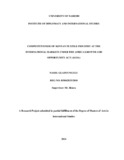| dc.description.abstract | One of the main advantages of textile and apparel industry was contribution to income
generation in by means of providing a market for cotton growers in rural areas. During the
post-independence period textile industry grew rapidly in the immediate due to the protection
offered to firms under the import substitution strategy. The main objective of the study is to
examine the competitiveness of Kenyan textile industry at the international markets under the
Africa Growth and Opportunity Act (AGOA). The study adopts a descriptive survey design.
This research design is appropriate since the study seek to describe the competitiveness of
Kenyan textile industry at the international markets under the Africa Growth and Opportunity
Act (AGOA). The target population for the study comprises of official at the Ministry of
Foreign Affairs and International Trade and owners of textile companies under the Export
Processing Zones (EPZs) and officials at Export Processing Zones. From the findings, .
Through AGOA the governments, civil society and the private sector work together in
building trade capability and expanding business links amid Africa and the US. Trade
capacity increase encompasses technical assistance on world trade rules, customs reform and
modernization. It is further driven by industry standards and regulations development,
enforcement of intellectual property rights and infrastructure transformation. After successful
recovery of Kenya‘s garment sector under AGOA, the cotton-to textile/garment sector is far
from realizing its true potential. However, the Kenyan cotton-to-textile/garment market
structure has the capability of competing with international markets such as china if well
managed. Importation of fabrics by the Kenya garment and apparel sector still remains a big
obstacle to the realization of its full potential and producing the right quantities. The study
recommends additional investments in infrastructure with a view to benchmarking
subsequent rates to international rates; enhance the efficiency of the transport and relate
service sectors of the ports, sustain technical skills trainings in order to increase
productivity, and sustain reforms in the business environment and business climate
including exploring the option of commercial representation in the US market. Further, the
cotton-textile chain has to be developed in a wholesome way. | en_US |

